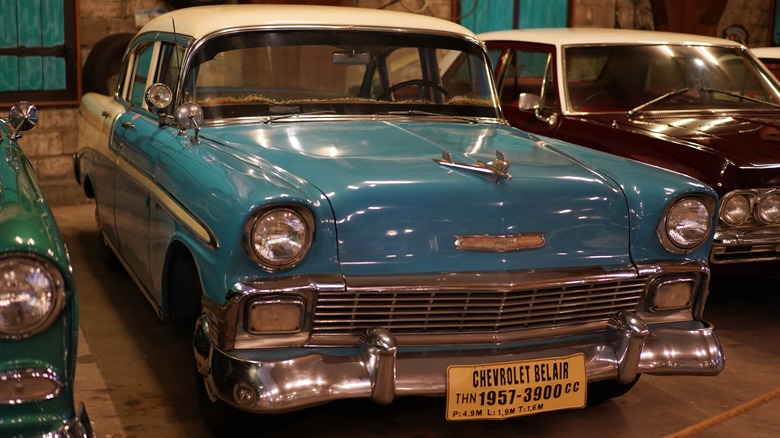The Most Iconic Chevy Models From The 1950s

The word “iconic” is thrown around so freely these days that its meaning is becoming as faded as the paint on an un-garaged classic car. When it comes to those very classics, however, the term still has a solid definition and well-earned place in the discourse. Iconic models helped establish a style or brand as standouts of their era or the industry as a whole, and they have carried that significance proudly through the following decades. Some of these vehicles found their way into popular culture, while others have relied on design or performance to become — as the 1976 Chevy television ad below proclaimed — as American as baseball, hot dogs, apple pie, and Chevrolet itself.
The 1950s was an extraordinary decade for Chevy, in terms of industry excellence and cultural significance. Digging through the catalog of ’50s Chevrolets reveals a handful of models that have earned status as true bowtie icons.
[Featured image by Gunguy09 via Wikimedia Commons|Cropped and scaled|Public domain]The Bel Air became known as simply the ’57 Chevy by that year

Puguh Fery/Shutterstock
Of all the models Chevrolet has produced since the brand was established in 1911, only one is known by its two-digit year of manufacture and the abbreviated moniker for the manufacturer. The 1957 Bel Air is commonly referred to as the ’57 Chevy, and has been a fixture at car shows almost since it rolled off the assembly line. It is truly a product of its time, with its broad, curved hood and fenders, generous use of chrome, and dramatic tailfins. The Bel Air first appeared in 1950, taking its name from the Los Angeles-area city of the same name.
The Bel Air evolved throughout the ’50s along with American cruiser culture, gaining V8 engine options and air conditioning in 1955. Volo Cars calls the ’57 Bel Air “An icon of its time, [and] one of the most sought-after classic vehicles.” A pristine convertible from that year sold for $330,000 in 2022.
The first-generation Corvette established the model as an industry icon

John Keeble/Getty Images
The Corvette has been one of Chevrolet’s highlights throughout its eight generations, getting faster and more impressive with each update. While the first generation that ran from 1953 through 1962 was woefully underpowered compared to modern iterations like the Z06 and the Stingray, its stunning styling and lightweight fiberglass body established the model as one of Detroit’s greatest sports cars ever. First-generation Corvettes have made big-screen appearances in classic films like “American Graffiti” and “It’s a Mad, Mad, Mad, Mad World,” as well as more recent productions like “La-La Land” and the billion-dollar 2023 smash hit “Barbie.”
The first-generation ‘Vette got fresh body designs in 1956 and 1958, and this model can still serve as the centerpiece of any car collection more than 70 years after its debut. Classic.com lists more than 1,000 C1 Corvette sales in the past five years, with an average price of more than $110,000. The cheapest ’50s specimen was the nearly bare shell of a green ’54 model that went for a little over $14,000, and the most expensive was a custom ’59 convertible that sold in 2021 for $825,000.
The One-Fifty starred in American Graffiti

Different_brian/Getty Images
Chevrolet made the One-Fifty in two generations from 1953 until 1957, with the update coming in 1955. It sat on the lower end of the Chevy lineup during its brief run, and was marketed heavily for fleet use, like as a police vehicle or taxicab. Chevy built more than 100,000 One-Fifties in each of the 1955, 1956, and 1957 model years, although it was nowhere nearly as popular as the Bel Air during that stretch. It shared the stereotypically ’50s design with its more expensive brother, though, and this easy identification with the era made the One-Fifty a Hollywood star. Three One-Fifties were featured in “American Graffiti,” including one that was the chosen ride of Harrison Ford’s Bob Falfa. Falfa wrecks his car in a dramatic street race against John Milner (Paul LeMat), but there were actually three identical cars used in the film.
All three One-Fifties were originally used in the 1971 film “Two-Lane Blacktop,” which starred folk-rock star James Taylor and Beach Boy Dennis Wilson. For “American Graffiti,” one car was restored for Falfa to drive throughout the film, another was towed for the crash scene above, and a third car was rescued from a salvage yard to be burned after the crash.
Fourth generation Suburban
The Chevy Suburban SUV has a longer unbroken production run than any other vehicle on the planet, with a history dating back to 1935 that spans twelve generations. The 1950s encapsulate two of those: the third generation ran from 1947 through 1954, and the fourth includes the 1955-1959 model years. For that fourth version of the Suburban, Chevy included modern tweaks like a 12-volt electrical system, tubeless tires, and a Posi-traction limited-slip differential in the rear axle.
The Suburban has been used in more than 1,750 films and television shows since 1952, a career that earned it a star on the Hollywood Walk of Fame in 2019. Don’t head to Los Angeles to see the star, though. After the General Motors plant in Arlington, Texas churned out its 12 millionth vehicle in 2021 (a 12th-gen Suburban), the model’s Hollywood star was moved to the Arlington Entertainment district between the baseball and football stadiums. 1950s Suburbans have appeared on TV classics “The Andy Griffith Show” and “The Man From U.N.C.L.E.” along with 1980s film favorites “Harry and the Hendersons” and “Mississippi Burning.”
[Featured image by liebeslakritze via Wikimedia Commons|Cropped and scaled|CC-By 2.0]First generation El Camino
The El Camino barely qualifies as a 1950s vehicle with its debut year of 1959, but shouldn’t be excluded from any list of Chevrolet’s most iconic models. It was meant to chip away at the market share of the Ford Ranchero, which had been around since 1957. The El Camino was built on the same base as the Brookwood station wagon, and saw a production run of 22,246 units for the 1959 model year. Three engines were offered on the debut-edition El Camino: a 235-cubic inch straight six and V8s measuring 283 or 348 cubic inches. Buyers who chose the W-series 348 got a high-performance cam and three Rochester two-barrel carburetors that helped that engine crank out 315 horsepower and 356 pound-feet of torque.
The 1959 El Camino is another of the many cars featured in the 1963 madcap road trip caper “It’s a Mad, Mad, Mad, Mad world.” It also made an appearance in the previous year’s James Bond flick “Dr. No,” along with a black 1957 Bel Air.
[Featured image by Chevrolet via Wikimedia Commons|Cropped and scaled|Public domain]

